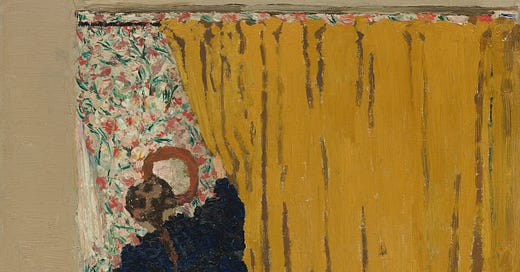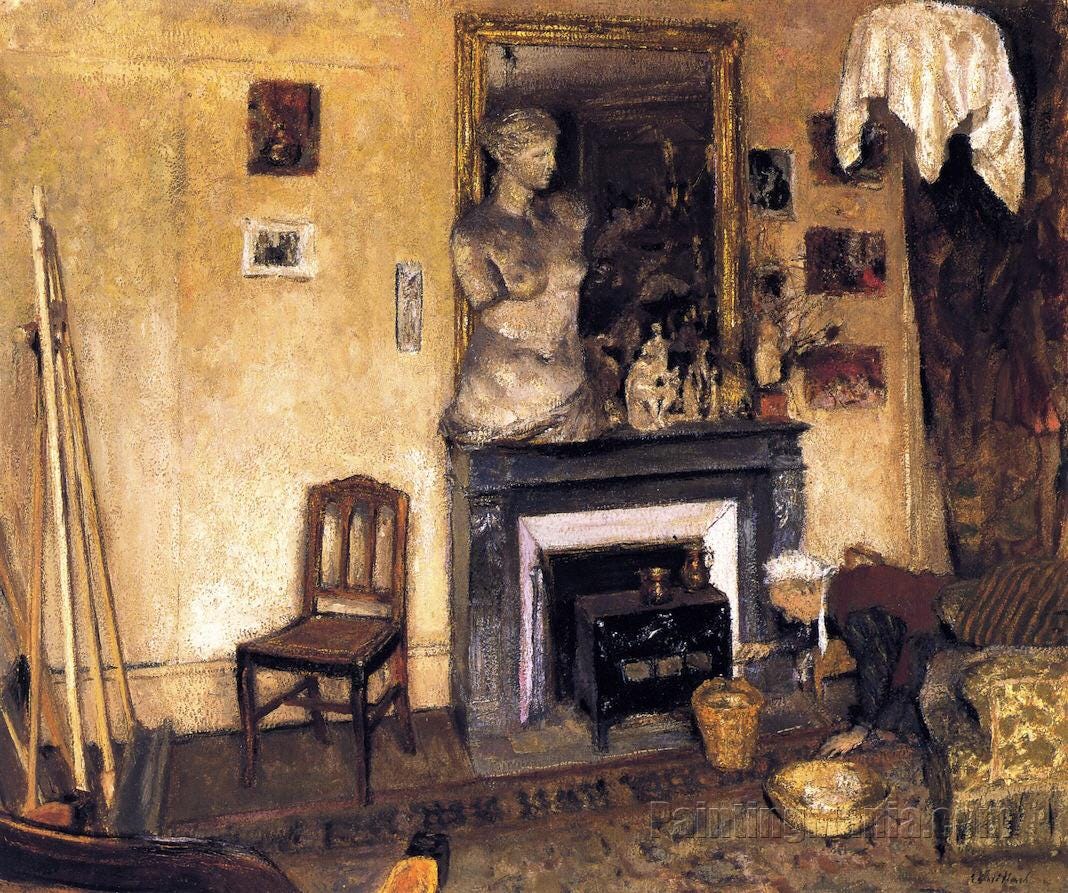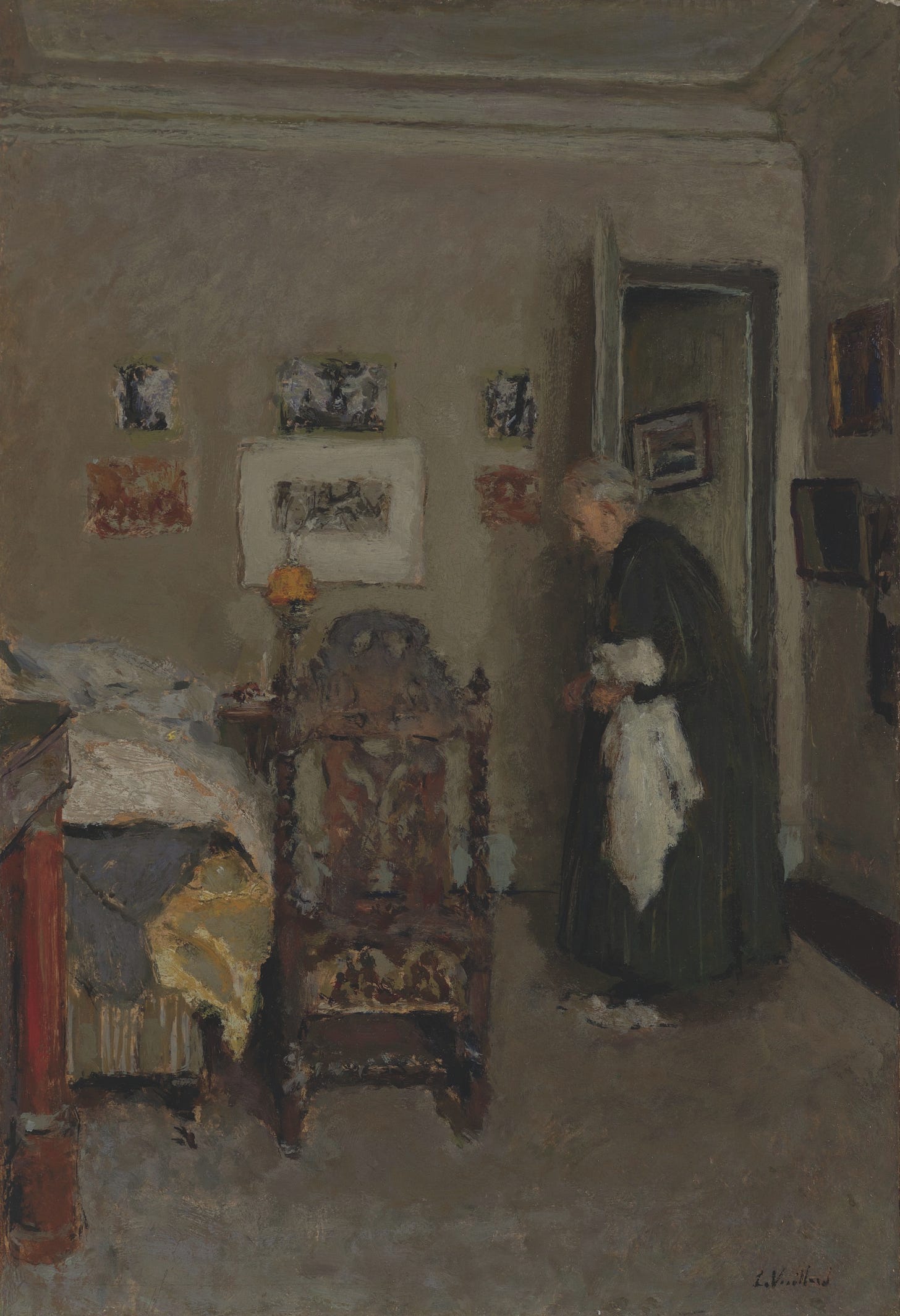The Spanish edition of Small Rain comes out this week, and I’m doing events in Madrid, Barcelona, and Granada. If you’re nearby, I’d love to see you at one of them. Later in June, I’ll be visiting the New York State Writers’ Institute at Skidmore College, reading with the poet Megan Fernandes (whose first book I loved; I’m excited to meet her).
I’ve carried my collection of Han Kang’s books with me across the ocean, and plan to reread them in preparation for our next To a Green Thought Book Club, where we’ll be discussing her most recent novel, We Do Not Part. That’s on Sunday, June 29, and we’ll record the Zoom for anyone who can’t join synchronously. Discussions are open to all Founding Members of this newsletter; you can join or upgrade your membership by clicking on the Subscribe button below.
This is a free newsletter. If you’re able, please consider supporting my work by becoming a paid subscriber.
*
At some point I plan to write another post about Édouard Vuillard, the French Post-Impressionist painter, and about the strange, distressing shape of his career. His little, exquisite “The Green Interior” was, for a time, my favorite painting on view at The Met; when I was living at 88th and Lexington, just a hop and a skip from the museum, many mornings I walked over to spend half an hour in its company. But this is a post with a more modest aim, to think about a single painting, and a different one: “The Yellow Curtain,” which Luis and I saw for the first time at The National Gallery a week or so ago. It stopped me in my tracks.
Like “The Green Interior,” “The Yellow Curtain” is a study in color, and as with many of Vuillard’s paintings from the 1890s, his great decade of exploration and invention, formal properties are at least as important as description or denotation. Which is not to say that subject matter doesn’t matter. One of the things I most admire about the painting is its approach to gesture, or to scene, or to gesture-as-scene. A woman drawing open a curtain—an entirely banal, everyday action—is invested with theatrical, totemic force.
A simple scene, and one at least apparently shorn of the interpersonal drama that often animates Vuillard’s paintings, in many of which multiple figures stand in relations that seem, much of the time, miserable and silent, putting me in mind more than once of another sad Edward: Edward Hopper. But in fact, as in a lot of Vuillard, the subject matter of “The Yellow Curtain” isn’t as legible as it might seem at first glance. As it seemed to me, at least: I think when I first looked at the painting, maybe for the first minute or two, I imagined this was a curtain in front of a window, opening up to an external space of impossible luxury and plenitude, the kind of extravagant flowered landscapes we might get in a later Bonnard.1
But it isn’t that at all, as is clear once you’ve given yourself a little time to see. Those aren’t flowers, but patterned wallpaper; the curtain doesn’t open onto an expansive, external world but a tiny interior, dividing the woman’s dressing room from the bedroom. (A helpful note in the catalogue from the National Gallery’s 2003 Vuillard retrospective, which included this painting, clarifies that such a division was typical in French homes at the time.) We can see her dressing table, and what is presumably a mirror on the wall above it. My momentary misreading and its correction meant a radical revision of my sense of the painting: from garden scene to interior, from expansiveness to something constrained, even cramped—as Vuillard’s interiors tend to be, reflecting the family’s poverty, which at times approached desperation.
All of this is clear enough, though if you really try to see the painting things quickly get strange. Vuillard often luxuriated in reflections, but this mirror doesn’t seem to reflect anything—though I think it should capture the woman’s face, or at least the yellow curtain. (Maybe it isn’t a mirror; maybe it’s some other circular something; I don’t think Vuillard lets us be sure.) If anything, it seems to be transparent, allowing us to see the wallpaper it should obscure, a little touch of the surreal. And what’s happening along the left side of the dividing wall? Those vertical white brushstrokes bulging out to the right of the wall might conceivably be a curtain of some sort, maybe being blown inward from an open window, though I’m not sure how likely a window would be in this space. (A window would explain how luminous it seems to be.) But I can’t find any plausible reading of the white / gray brushstrokes below these, bulging to the left, as though somehow the wallpaper were creeping into the bedroom proper. Vuillard seems to cultivate ambiguity, the space won’t fully or finally resolve; often his paintings cling in this way to a residue or remainder of mystery.
The woman is Vuillard’s mother, often called the most painted mother in art history, the subject of more than five hundred paintings Vuillard made throughout his life. (He lived with her until her death in 1928, when she was eighty-nine and he was sixty.) “My mother is my muse,” he told Jacques Salomon in 1920. She fascinated him; again and again he captures her in the routine motions of her day, motions that he often endows with drama, mystery, and profound emotion. About a much later painting, “Madame Vuillard Lighting the Stove,” he wrote in his journal: “the effect…of the dirty, shoddy aspect of the things in my room, suddenly seeing clearly what they mean to me, Maman stoking her little wood stove; savoring her support.” One senses that many of his paintings, including “Yellow Curtain,” are responses to similar moments, to a sudden pang, an awareness of the emotional currents traversing quotidian experience. (Maybe “muse” is just the name we give to someone who sensitizes us to such currents, who wakes us up to them.)
I think even without this history one can sense some of the emotion invested in the figure. She’s intricately painted, about which more in a bit: her robe or nightgown is the second most activated field in the image, after the floral wallpaper; and her hair is lovingly detailed, with patches of lighter and darker brown. His mother’s hair was a fixation of Vuillard’s throughout his life; he painted her with it up and down, in the act of doing and undoing it; one of the most moving images he ever made is a late photograph of her at her toilette in the last weeks of her life, completely bald. It’s amazing how much access she gave him, how vulnerable she was willing to be and how little vanity she had. As with many of Vuillard’s paintings, we’re made voyeurs, and to an even intenser degree, given the doubled intimacy of this scene: already in the intimacy of the bedroom, we glimpse the even greater privacy of the dressing alcove.
Revelation inheres in the gesture, uncovering something that had been hidden. We might be in a temple, about to enter the sanctum sanctorum; or in a theater, the dividing wall serving to frame (a second frame within the frame of the painting itself) a stage on which some significant action will be performed. Theater was crucial to Vuillard’s marvelous decade, and a good deal of the stylized strangeness of his best paintings might be traced to his fascination with puppets and shadow theater. He helped design the production of his friend Alfred Jarry’s scandalous Ubu roi; from his work on plays by Isben and Strindberg he learned to weight apparently unassuming domestic scenes with a sense of hidden drama and, often, foreboding. The mother’s gesture here seems ambiguous to me: is she about to sweep the curtain fully open, laying bare to the painter (and to us) all her secrets? Or is she about to slip to the other side and let it fall closed again behind her? Is the gesture an invitation? Or is she asserting her privacy, the hiddenness of a world that will remain hidden?
*
But all of these thematic thoughts were secondary to my experience of the painting, the result of close reading; my first, overwhelming response was to formal relations. It might as well have been (as some of Vuillard’s most daring paintings almost become) an abstraction. It embodies the ideal that Maurice Denis, the theorist of the Nabis, articulated in a very famous sentence: “Remember that a picture, before being a battle horse, a female nude or some sort of anecdote, is essentially a flat surface covered with colors assembled in a certain order.”
Color was the first formal relation I felt, the painting immediately organizing itself into yellow and not-yellow. I’m not sure any reproduction can convey how thrilling this is in person, the drama created by the yellow curtain, the yellow bed. Except they’re not exactly yellow, are they? They’re a little darkened, a little muddied: ochre, maybe, despite the title. (I should say I don’t know where the title came from, but it’s probably not Vuillard’s; with a few exceptions, he mostly left the paintings from this period without title.) You can see the difference in the brighter patch of yellow near the foot of the bed, or in the very few tiny strokes of a much purer yellow in the wallpaper.
The painting is more interested in color than in the reality of objects invested with color, it seems to me. The folds of the curtain are notional, gesture more than mimesis; there’s no real attempt to convey the weight or bunching of actual fabric. There’s even less of an attempt with the bed, its yellow covering nothing but a color field; it might as well be a woodblock print. The same is true of the neutrally colored wall, though there’s a suggestion of depth in the thick line of shadow along the bottom of the lintel; and there’s a bit of reality in what I take to be a glint of light on the otherwise brownish red of the foot of the bedframe anchoring the image in the lower right hand corner. Something that interests me in Vuillard is how variable his commitment to the notation of reality can be, at times fastidious and at times casual. Repeatedly he asserted the primacy of emotion over such notation. In his journal, in 1890, he wrote: “A woman’s head provokes a certain emotion in me, I should make use of this emotion alone and not try to remember her nose or her ear, they are completely unimportant.”
Almost as immediately powerful as the yellow / not-yellow relation is that between the horizontal bed, lintel, dressing table surface, and curtain rod, versus the verticality of the curtain, the left-hand border made by the wall, and the foot of the bedframe. (There are also two important diagonals: the mother’s arms, and what seems to be a seam or crack in the dividing wall.) This verticality / horizontality is echoed in the brushstrokes, which over most of the canvas are carefully controlled and almost uniform, moving in a single direction, nearly hatch marks. This draws enormous attention to the forms that violate this dualism: the head of the bed, with its covered pillow; the curtain where the mother draws it aside; and the mother herself, who leans to the left. There’s an almost perfect echo between these figures, all of them striking almost exactly the same angle, which creates to my eye a wonderful harmony in the left half of the painting. (In the right half of the canvas, the only non-linear form is the foot of the bedframe, a curve that echoes the overlapping circles of the mother’s head and the mirror mounted to the wall.)
The mother is a source of organic forms: the curves of her body, her dangling braid; she also creates the sole field in the painting where verticality and horizontality interact. This is a little hard to see, or at least I took my time seeing it; but her robe, which seemed to me at first monochromatic, is in fact anything but: here Vuillard is careful, almost obsessive in his notation, capturing a checkered pattern of electrically vivid blue, black, and green. How different from the bedspread: here the painting does convey, in this obsessively worked surface, the texture of fabric, a kind of tactility I often feel in Vuillard, as in many of the painters I love; it makes you want to run your fingertips across the paint.
Probably nothing influenced Vuillard’s aesthetic more than the patterns and textures of fabric. His grandmother, uncle, mother, and sister all worked with textiles. After his father’s death, his mother made corsets in the family home (where Vuillard, as an art student, had no room of his own); his sister, who attended a prestigious boarding school but failed to secure a rich husband, made herself vividly patterned, fashionable dresses. When you see photographs of the homes Vuillard lived in, you realize how closely his hyper-stylized canvases were in fact notating reality, with women in wildly patterned dresses moving among rooms covered in wildly patterned wallpaper.
Which brings me to the zone of the painting I’ve left for last, because it’s so delicious: the flowered wallpaper. Another way of organizing the painting formally might be between order—whether vertical or horizontal—and disorder, with the dividing wall (with its staid, controlled, unidirectional brushstrokes) representing an extreme of order, and the mother’s robe a kind of intermediate space, the grid evident in the fabric of her upper back giving way to something less orderly in the sleeves and her lower torso.
And then there’s the alcove’s wallpaper, which presents an entirely different kind of mark-making from anything else in the picture. There’s almost no horizontality or verticality here, almost no lines of any kind. Instead there are little squiggles and dots and daubs of paint, and compared to the mostly monochromatic fields of the rest of the painting, something like a riot of color: pinks, reds, whites, greens, yellows, blues. Though I’ve been calling it, I think rightly, the “flowered wallpaper,” the flowers are mostly notional, something our minds compose from marks that have almost entirely freed themselves from notation. It’s not just a different style but almost a different century of painting, like a patch of canvas lifted from Cecily Brown. You can feel the exuberance of this zone of the painting, you sense the fun he was having. I’m struck by how much power it draws from the contrast with the rest—and by how powerful a sense the picture gives of whatever energy or force is unleashed here being tightly contained.
This long, belabored reading is an attempt to account for the experience I had in the first few minutes of looking at the canvas in the National Gallery; I’m still just beginning to see it. The point of all the looking is that I sense something in it I want to learn: the concentration of force in a gesture; the very powerful suggestion of scene; the intimacy; the power of contrast to make you feel form. One last, tiny, detail, something I noticed only after a long time looking, and that delighted me so much I had to call Luis back from where he had wandered off, to make sure he saw it too. It’s easy to miss, maybe an inch or so from the bottom of the canvas, just slightly to the right of center: a tiny daub, almost a circle, of blue, white, and black. What in the world is it doing there? It can hardly be notational; it could almost be a stray fleck of paint, though I don’t think for a minute it is. Something intentional the intention of which is utterly mysterious to me, and I think invincibly so: there’s no figuring out what it’s doing there. There aren’t words for how wonderful I think it is.
As always, thank you for reading—
G.
Bonnard and Vuillard were lifelong friends, the most brilliant of the fin-de-siècle circle of artists known as Les Nabis. They began sharing a studio in 1891, though I’m not sure if that lasted long enough for “The Yellow Curtain,” from 1893, to have been painted there.









Thank you for this beautiful essay, a lesson in Deep Looking. My hunch is that the small blue dot is meant to capture his mother’s attempt to mend a small tear in the fabric by embroidery. My grandmother used to do the same with bed sheets or other fabric. Given that such fabric was much more expensive then, I believe this was a way to salvage it—and also to make it unique.
A bit like Kintsugi in Japan.
reminded me a lot of tj clark. after i read him, i was thinking about how hard it is for me to pay as much attention to images as he did, something about the onslaught of images online and how they've made me pay less attention to each one. i really admire your ability here to look so closely/alively. beautiful writing!